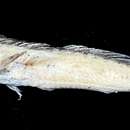Comprehensive Description
(
Inglês
)
fornecido por Smithsonian Contributions to Zoology
Mimoblennius atrocinctus (Regan)
Blennius atrocinetus Regan, 1909, pp. 404–405, pl. LXVI, fig. 1 [original description; type-locality: Christmas Island].
MATERIAL EXAMINED.—BMNH 1909.3.4.70 (juvenile, 21.5 mm SL), holotype of Blennius atrocinctus, Christmas Island, lat. 10°30′S, long. 105°40′E, 1909, C. W. Andrews; USNM 203095 (1, 44.2), original no. GVF 1731, sta. HK 54, Hong Kong, New Territories, north end of Shelter Island, entrance to Port Shelter, lat. 22°20′00"N, long. 114°17′42"E, depth ca. 1–4 meters, 24 April 1958, Rolph L. Bolin; USNM 197980 (3, including 1 cleared and stained, 20.1–23.4) and CAS 24155 (2, 24.3–32.4), locality data same as USNM 203095, 20 August 1963, W. L. Y. Chan; USNM 204624 (7, 14.5–40.7), Ceylon, Trincomalee, small cove north of harbor, lat. 8°34′N, long. 81°13′E, large rock outcrop devoid of coral, approx. 50 meters off shore, depth 0–4 meters, 26 June 1969, W. F. Smith-Vaniz, S—V 69–119.
DESCRIPTION.—(Meristic characters for holotype in parentheses.) Dentary a closed capsule with replacement teeth entering functional series through foramina in bone. Canine on each dentary posteriorly. Premaxillary and dentary teeth immovable or nearly so; premaxillary teeth 30 to 34 (32); dentary teeth 25 to 30 (26). Vomerine teeth absent. Terminal vertebrae with two epurals and autogenous hypural 5 and ventral hypural plate. Vertebrae 10 + 25 to 28 = 35 to 38 (38); epipleural ribs 15 to 19; last pleural rib on vertebra 10. Circumorbital bones 5.
Dorsal spines 13; last spine noticeably reduced; segmented rays 16 to 19 (17); basal two-thirds of terminal dorsal ray bound by membrane to caudal peduncle; dorsal fin moderately incised between spinous and rayed portions. Anal spines 2; segmented rays 19 to 21 (20); basal two-thirds of terminal anal ray bound by membrane to caudal peduncle. Caudal fin with 13 segmented rays, middle 9 each branched; dorsal and ventral procurrent rays 7. Pelvic rays I,3. Pectoral rays 14 or 15 (14). Pectoral radial formula 2–0–2 (based on 1 cleared and stained specimen). Gill-rakers 10 to 11. Pseudobranchial filaments 5. Nuchal cirri palmate, with 4 or 5 short, rounded branches; supraorbital cirri consisting of 2 long, slender cirri over each eye; anterior nasal cirri palmate, with 3 to 5 branches, posterior nasal cirri absent or minute. Upper and lower lips entire. Lateral line of simple pores ending beneath 4th or 6th dorsal spine or continuous to point below level of 4th dorsal spine, thence curving downward and continuous as short, separate, longitudinally bipored tubes to point opposite tip of median rays of appressed pectoral fin (at level of 11th dorsal spine).
In most specimens the head and body have a pale ground color. The pattern of melanophores is considerably variable. Most specimens bear a dusky mark along the posterior border of the orbit and irregular dusky marks over the opercle. The underside of the head and prepelvic region are dusky to black with occasional evidence of bands under the head. The side of the body may be irregularly dusky, darker on the ventral half, with dark spots at midlevel, or with about 7 vertical dark bands. The dorsal fin usually bears a dark spot between the first two rays, usually paler than in M. cirrosus. There may be dark extensions of the body bands on to the basal portion of the dorsal fin and sundry other dusky marks over the fin. The anal fin may be pale dusky, darker at the ray tips, or almost uniformly black. The caudal fin rays bear dusky spots aligned in irregular vertical rows. The pectoral fin rays are dusky and the pelvic fin rays are dusky to almost black.
The life colors were given by Regan (1909, p. 405) as “reddish, with 6 blackish cross-bars continued on the basal part of the dorsal fin; anal blackish.”
GEOGRAPHICAL VARIATION.—See comments under Mimoblennius cirrosus.
- citação bibliográfica
- Smith-Vaniz, William F. and Springer, Victor G. 1971. "Synopsis of the tribe Salariini, with description of five new genera and three new species (Pisces: Blenniidae)." Smithsonian Contributions to Zoology. 1-72. https://doi.org/10.5479/si.00810282.73

